When tasked with fitting out a daycare, choosing the right equipment for small spaces becomes a critical challenge. Limited space demands smart, versatile solutions that don’t compromise on durability or functionality.
Are you facing the challenge of furnishing a daycare in a small space? If you’re looking for the perfect balance between functionality, safety, and space-saving design, you’re in the right place. We’ll explore how to make the most of your limited space while creating a welcoming and engaging environment for children.
Finding daycare equipment that is both space-saving and durable is not only possible but essential for small daycare environments. It’s about selecting multifunctional pieces that can withstand daily wear and tear while maximizing the available area. Look for items designed with a compact footprint, made from robust materials, and offering multiple uses to cater to the dynamic needs of a child-friendly space.
The quest for the perfect small-space daycare setup is not just about aesthetics; it’s a strategic endeavor aimed at fostering a safe, engaging, and comfortable learning environment for children.

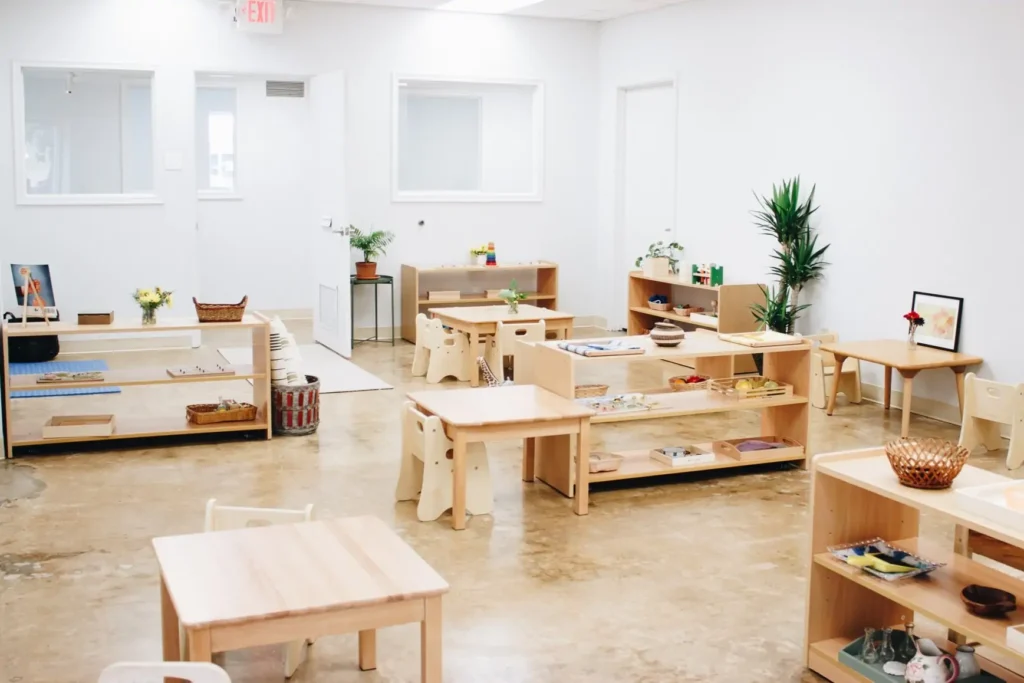
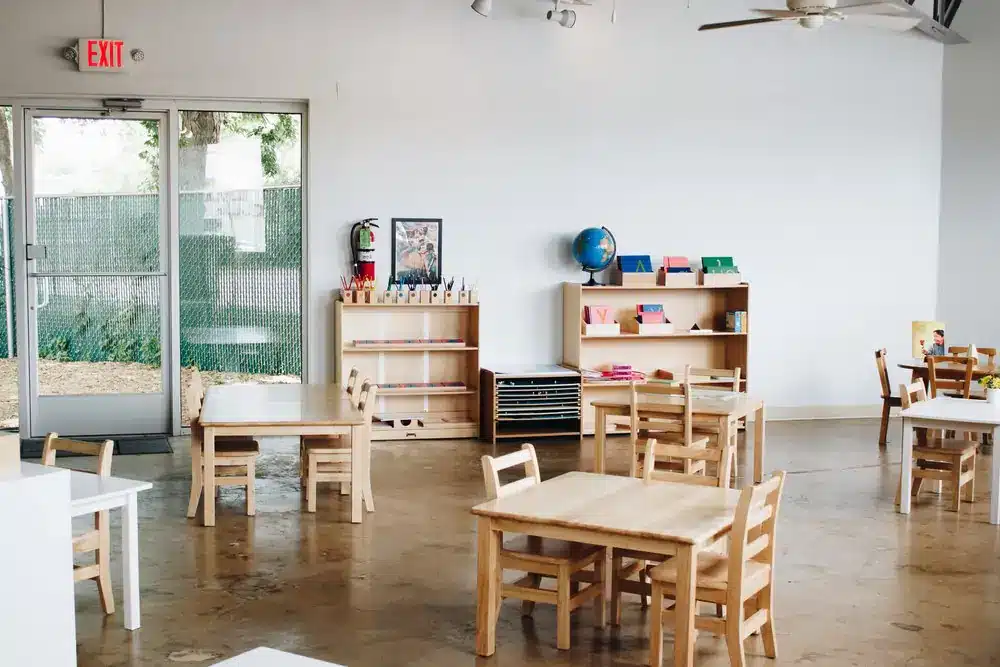
Is it possible to find daycare equipment that is both space-saving and durable?
Absolutely! When it comes to small spaces, it’s essential to prioritize furniture that is both compact and built to last. Look for multi-purpose pieces that serve multiple functions. For example, opt for tables with built-in storage or chairs that can be stacked to save space when not in use. Investing in high-quality, durable furniture will ensure that it withstands the demands of daily use in a daycare setting.
Finding daycare equipment that ticks both boxes of being space-efficient and durable is absolutely possible and essential for small daycare centers. The key is to look for furniture designed with compact spaces in mind without compromising on quality or longevity. Manufacturers specializing in daycare and educational furniture often offer products that are robust, easy to clean, and designed to withstand the energetic activities of children. For example, chairs and tables made from high-density polyethylene are not only lightweight and easy to move but also resistant to stains and scratches, making them ideal for a bustling daycare environment.
When considering durability, it’s important to focus on the daycare equipment that can withstand daily use and are made with safe, non-toxic materials. Look for certifications or endorsements from reputable organizations as a sign of quality. Additionally, furniture with rounded edges and smooth finishes can prevent injuries and are generally more durable as they’re less likely to chip or break.

What are the key considerations when choosing daycare equipment for small spaces?
Selecting the right daycare equipment for small spaces requires careful consideration of several factors to ensure that every item serves a purpose and contributes to a functional and welcoming environment. Here are the key considerations:
- Multifunctionality: Choose daycare equipment that can serve multiple purposes. For instance, tables with built-in storage can be used for activities and also keep supplies organized. Similarly, benches that open up to reveal storage space can serve as seating and a place to store toys or learning materials.
- Safety: Safety is paramount in any daycare equipment. Ensure that the furniture meets safety standards and is free from any potential hazards. Look for rounded edges, sturdy construction, and non-toxic materials. The furniture should also comply with national safety standards to ensure the well-being of the children.
- Flexibility and Mobility: In small spaces, the ability to easily rearrange daycare equipment is crucial. Lightweight pieces, foldable designs, or furniture on casters can be moved or stored away when not in use, allowing for the space to be adapted for different activities throughout the day.
- Aesthetics and Environment: The look and feel of the furniture can significantly impact the daycare’s atmosphere. Bright colors and playful designs can stimulate children’s imagination and creativity, making the space more inviting and enjoyable.
- Size Matters: Measure the available space in your daycare center to ensure that the daycare equipment you choose fits perfectly. Oversized pieces can make the room feel cramped, while furniture that is too small may not be practical or comfortable for children.
- Functionality: Opt for furniture that serves multiple purposes. For example, choose chairs that can be used as storage bins or tables with adjustable heights to accommodate different age groups.
- Easy Maintenance: Select daycare equipment that is easy to clean and maintain. Children can be messy, and having furniture that can withstand spills and frequent cleaning is essential.
- Sustainability and Quality: Invest in high-quality daycare equipment that will last for years. Sustainable materials like solid wood or recycled plastics are not only better for the environment but often offer greater durability than cheaper alternatives.
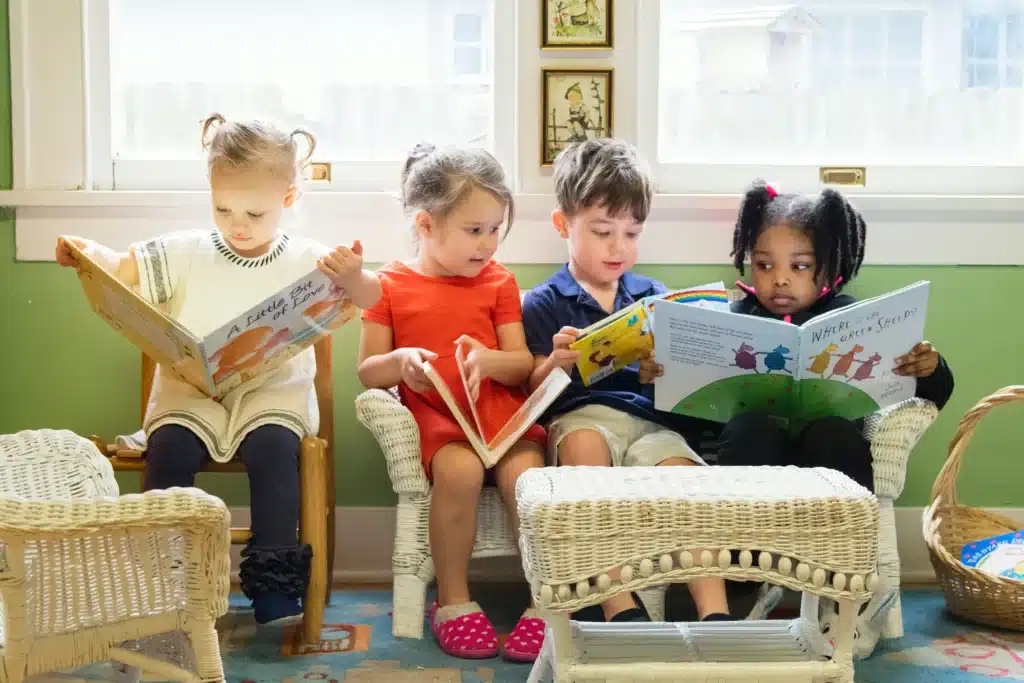
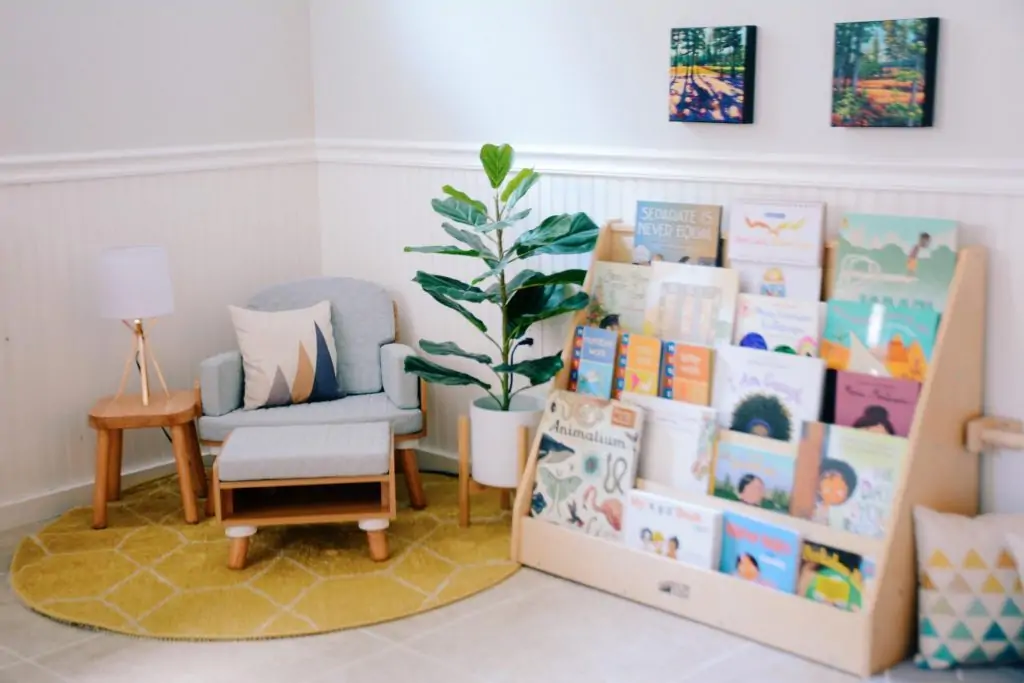
How can I maximize the use of vertical space in my daycare center?
In small daycare centers, maximizing vertical space is a clever strategy to increase storage without sacrificing floor space. Utilizing the walls for storage and displays can make a significant difference. Wall-mounted shelves, cabinets, and hooks can keep materials organized and off the ground, making the area feel larger and more open. Additionally, vertical space can be used creatively for learning and play. For example, a wall-mounted felt board or magnetic board can provide an interactive activity area without taking up any floor space.
Safety should always be a priority when using vertical space. Ensure that all wall-mounted furniture and storage solutions are securely anchored to prevent accidents. It’s also important to place items used frequently by children within their reach, while items used less often or by adults can be stored higher up.
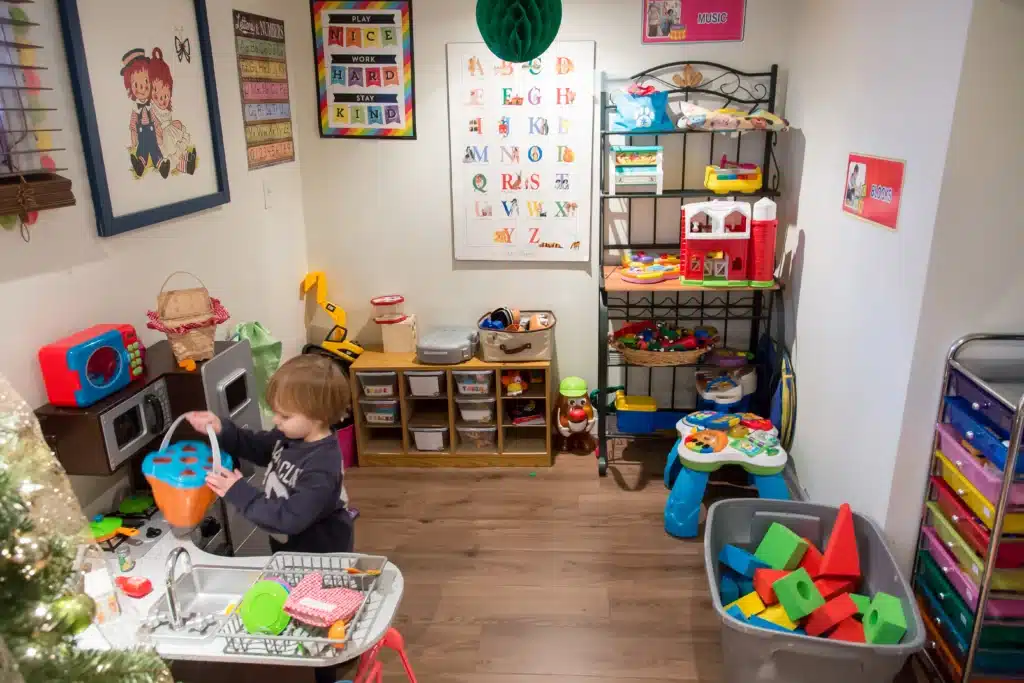
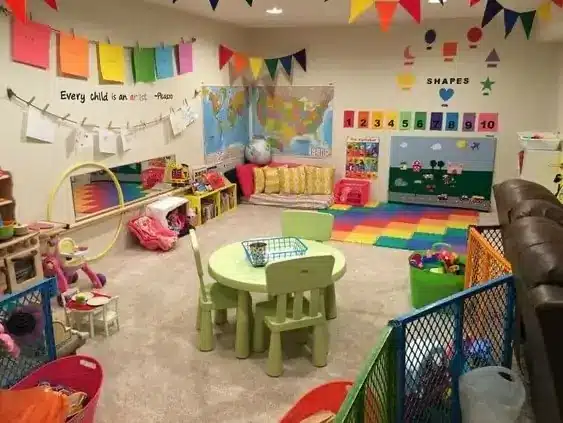
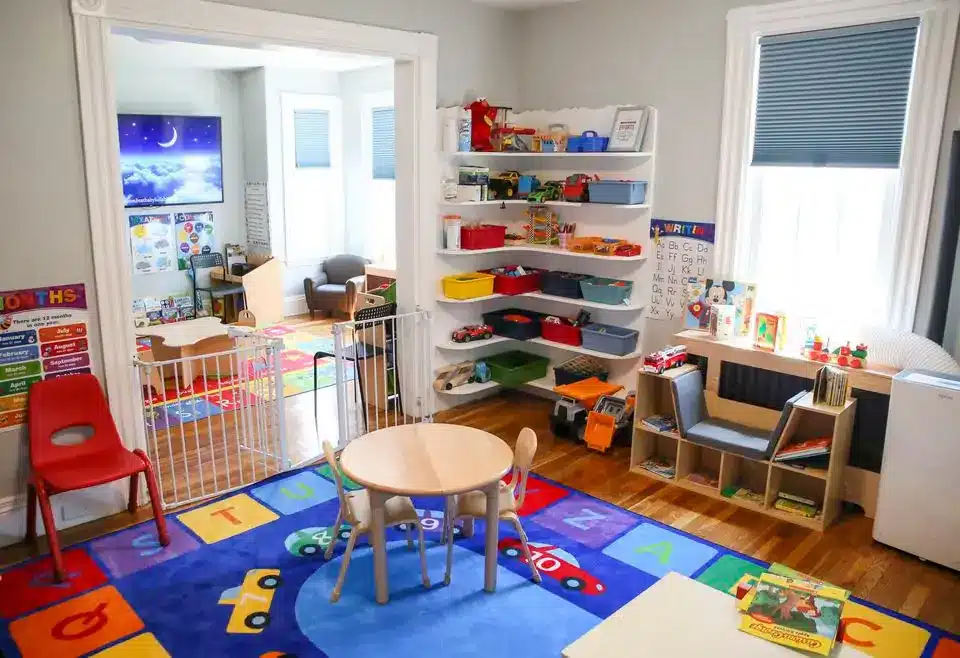
What about seating options for small spaces?
Seating is an essential aspect of daycare equipment, and it’s important to choose options that maximize both comfort and space. but traditional options can take up valuable space. In small environments, consider space-saving seating solutions like stackable chairs, which can be easily stored away when not needed. Another option is floor cushions or mats that can be used during story time or group activities and then hung up or stored in a basket to free up space.
For activities that require tables, consider adjustable-height stools that can be tucked under the table when not in use. These stools can serve double duty, accommodating children of different ages and sizes. Additionally, look for seating that is lightweight and easy to clean, with durable materials that can withstand spills and stains.
Effective Storage Solutions for Compact Daycare Settings
In compact daycare environments, effective storage solutions are not just beneficial; they’re essential. The goal is to maintain an organized, clutter-free space that promotes an optimal learning and playing environment.
- Under-table Storage: Tables designed with built-in storage underneath can dramatically reduce clutter by providing a home for toys, art supplies, and educational materials. These tables serve a dual purpose by facilitating activities on their surface while storing materials below, thus maximizing the utility of every square inch of floor space.
- Wall-mounted Solutions: Utilizing vertical space wisely can transform the functionality of a small daycare center. Wall-mounted cubbies, shelves, and hooks can store books, craft supplies, and personal items at eye level for easy access, keeping the floor space clear for play and movement. Securely anchored wall units ensure safety and accessibility, making the most out of available vertical space without compromising on the daycare’s aesthetic appeal.
- Multifunctional Pieces: The daycare equipment that serves more than one purpose can be a game-changer. Benches with hidden storage, foldable tables with shelving, and convertible play areas not only save space but also add to the versatility of the environment. These pieces allow for quick transitions between activities, making them invaluable in a setting where flexibility is key to daily operations.
Look for multifunctional daycare equipment that can transform based on the needs of the day. Tables with adjustable heights can serve as a lunch area, an arts and crafts station, or even a sensory play table, depending on the activity planned. Similarly, seating options like stackable stools or chairs that can be easily moved and stored can quickly open up the floor for group activities, circle time, or free play. By investing in versatile daycare equipment, daycare centers can maximize their usable space without sacrificing the quality of care and education they provide.
Creating Flexible Learning Environments in Small Spaces
Flexibility in small daycare settings allows for the environment to be reconfigured for various activities, supporting a dynamic and engaging curriculum. Portable dividers can quickly turn an open space into dedicated areas for quiet reading, imaginative play, or nap time, providing versatility without permanent structural changes. These dividers can be adorned with educational materials or artwork, further enhancing the learning environment. The use of foldable daycare equipment, such as collapsible tables or retractable play mats, enables caregivers to set up or dismantle activity areas swiftly, ensuring the space meets the evolving needs of the children throughout the day.
Leveraging Outdoor and Indoor Integration
When indoor space is limited, seamlessly integrating outdoor learning opportunities can expand the effective teaching environment. Durable outdoor daycare equipment, such as weather-resistant tables and benches, extends the classroom to the outdoors, where children can enjoy nature and engage in physical activities. Incorporating elements of outdoor play into the indoor setting with natural light, plants, and materials like wood and stone can also bring a sense of the outside world into the daycare, fostering a connection with nature even when space is constrained.

The Role of Color and Design in Small Daycare Spaces
The thoughtful use of color and design in daycare equipment and decor can significantly impact the atmosphere of a small space, making it feel brighter, larger, and more welcoming. Opt for colors that stimulate but do not overwhelm; soft blues and greens can create a calming effect, while bright accents in areas designated for play and creativity spark excitement and imagination. Incorporating child-friendly motifs and shapes in furniture design not only adds visual interest but also supports the educational goals of the daycare, as these elements can be used to teach colors, shapes, and themes.

Enhancing Spatial Perception Through Design
Mirrors strategically placed around the room can enhance natural light and create an illusion of more space, making the daycare feel open and airy. Choosing daycare equipment with sleek, modern lines can also contribute to a sense of spaciousness, avoiding bulky items that can make the area feel cramped. Furniture that can be nested or tucked away when not in use is particularly beneficial in small settings, ensuring that every piece is both functional and space-efficient.
Incorporating Outdoor Elements into Indoor Spaces
- Natural Materials: Emphasize the importance of choosing daycare equipment made from natural, sustainable materials for health and environmental reasons.
- Biophilic Design: Discuss how incorporating plants, natural light, and nature-themed decorations can improve air quality and create a calming, inviting space for children.
Bringing the outdoors in enriches the sensory experience of children in daycare, promoting well-being and inspiring curiosity about the natural world. Indoor vertical gardens or simple container plants can introduce children to the basics of gardening and botany, integrating science lessons into daily activities. The daycare equipment made from natural materials, like bamboo or sustainable wood, not only is durable and eco-friendly but also adds a warm, inviting feel to the space. Elements such as water features or aquariums can create a tranquil atmosphere, offering sensory play opportunities and teaching children about different ecosystems.
Fostering Environmental Awareness
Incorporating environmental themes into the daycare curriculum through daycare equipment and decor choices encourages early awareness of sustainability and conservation. Educational posters about wildlife, recycling bins designed for little hands, and play areas that mimic natural habitats can all contribute to a deeper understanding and appreciation of the environment. This approach not only makes efficient use of limited space but also embeds important values in the daycare experience.
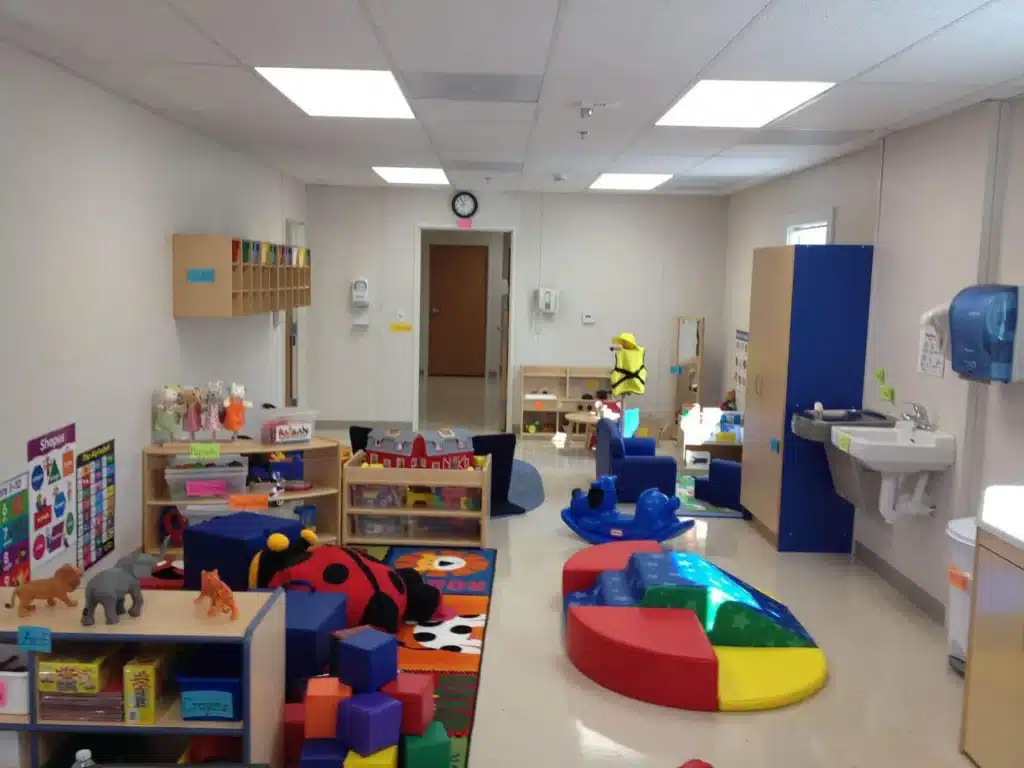

Utilizing Technology to Enhance Small Daycare Spaces
Integrating technology thoughtfully into daycare equipment settings can offer innovative solutions for space limitations while enriching the educational experience. Interactive whiteboards or digital display screens can replace the need for bulky bookshelves and storage units, providing access to a vast library of resources in a compact form. Augmented reality (AR) apps can turn a simple play area into an interactive learning environment, where children can explore outer space, the depths of the ocean, or the intricacies of the human body without leaving the daycare.
Balancing Technology and Traditional Play. While technology offers exciting educational possibilities, balancing digital interactions with traditional play is essential. Selecting daycare equipment that encourages both tech-based learning and hands-on activities ensures that children benefit from a well-rounded experience. Activity tables with built-in tablet holders can be used for guided learning apps, then cleared for art projects or sensory play, providing a seamless transition between digital and physical learning environments.
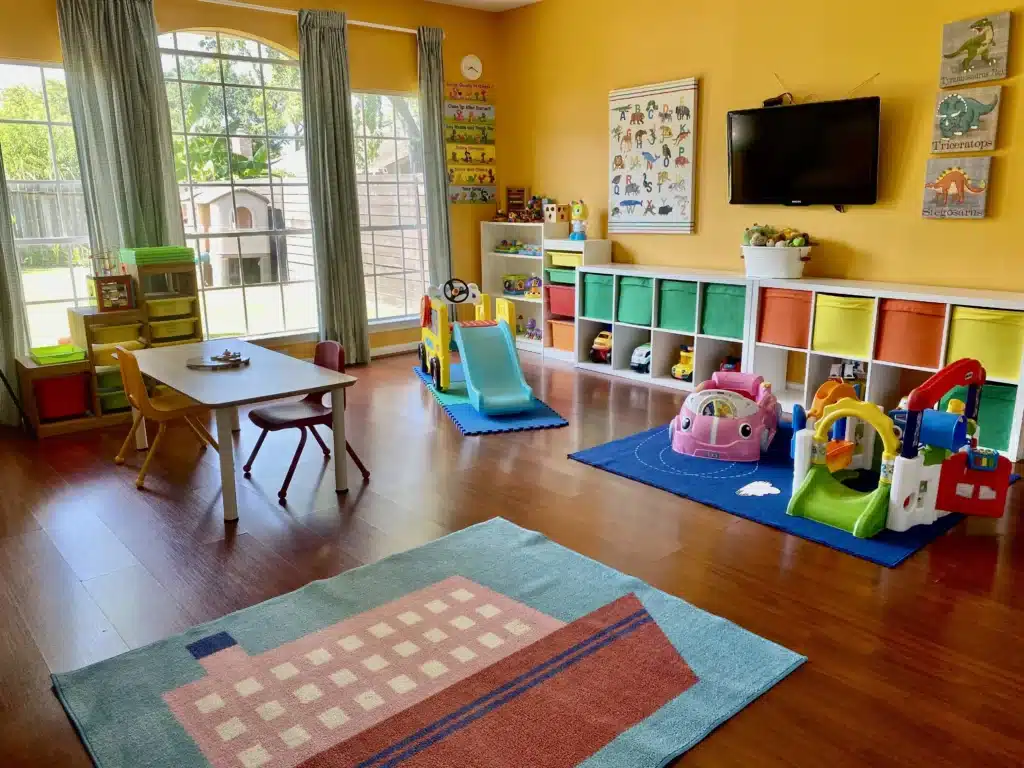
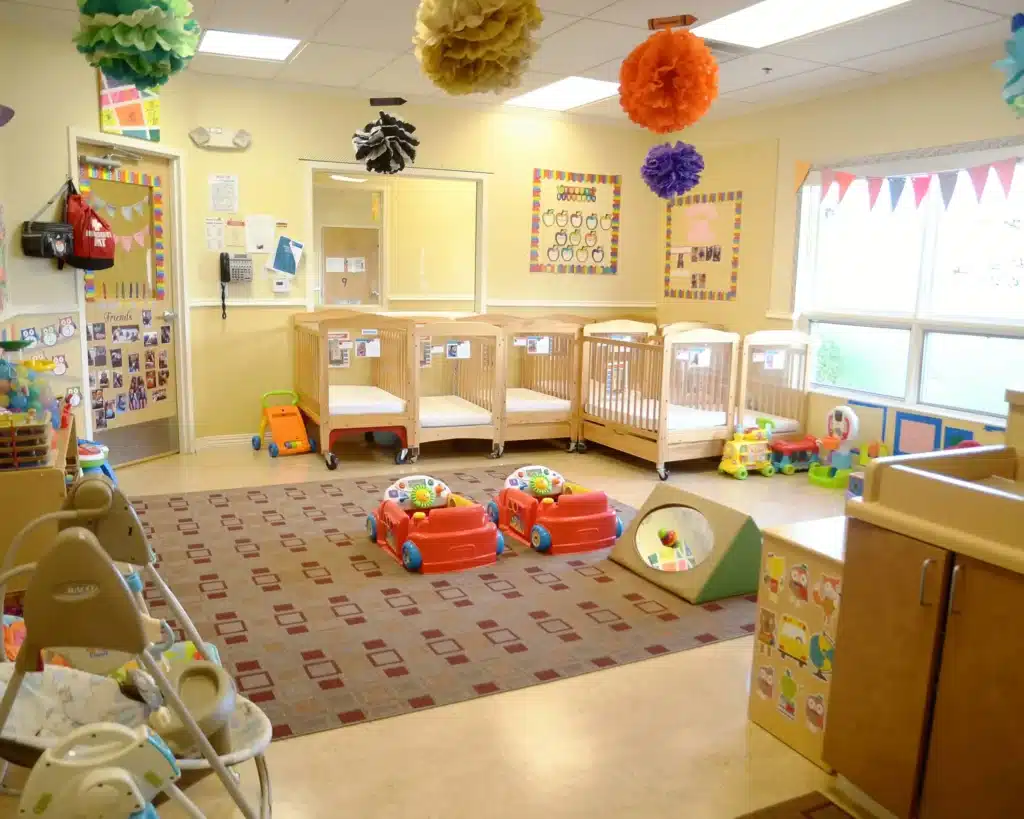
Strategies for Maximizing Floor Space for Active Play
Active play is crucial for child development, making it important to maximize available floor space for movement and exercise. Daycare equipment that can be easily stacked or hung on the wall frees up valuable area for physical activities. Designating specific daycare equipment for active play, such as soft foam climbers or mats that can be rolled out, ensures that children have safe and designated areas to explore and expend energy. Creating a schedule that rotates activities can also help manage the use of space, ensuring that all children have ample opportunity for active play throughout the day.
- Activity Rotation: Suggest a system for rotating active play equipment in and out of the space to ensure variety without clutter.
- Compact Daycare Equipment: Provide examples of space-efficient daycare equipment, like foldable gymnastics mats and stackable soft play blocks, that encourage physical activity.
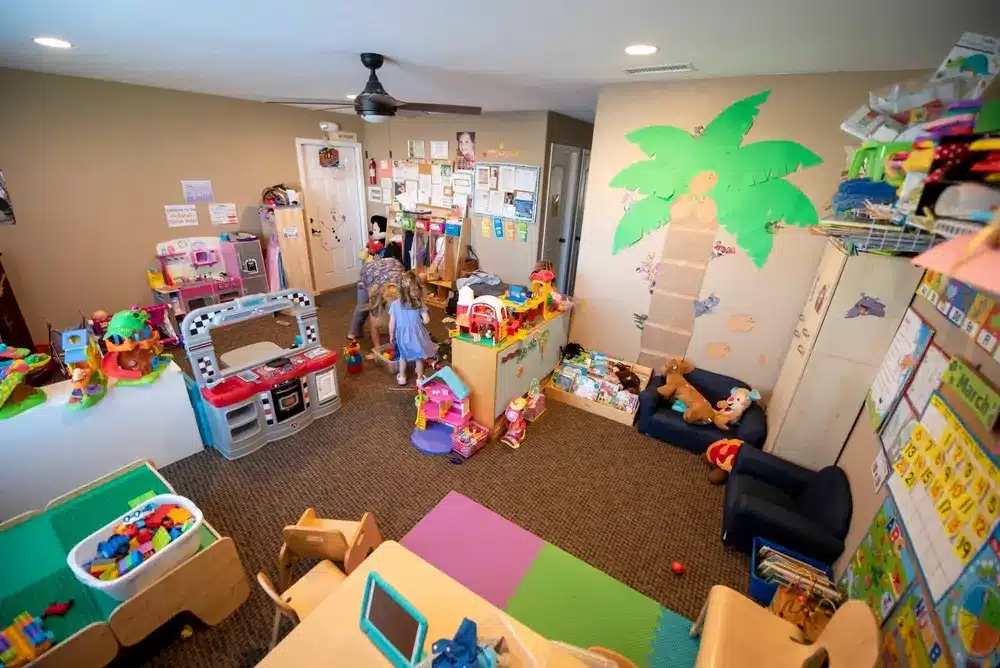
Encouraging Movement in Limited Spaces
Incorporating elements of physical education into the daily routine can be challenging in small spaces, but with creative planning and the right daycare equipment, it’s possible to foster a love of movement. Balance beams that can be assembled and disassembled, hopscotch mats that roll up for storage, and small trampolines with foldable legs can all provide vigorous exercise options without requiring a permanent allocation of space. Encouraging activities such as dance, yoga, or simple stretching exercises can also promote physical well-being, requiring minimal daycare equipment and space.
Maintaining a Safe and Clean Environment with Compact Daycare Equipment Choices
In compact daycare environments, maintaining a high standard of cleanliness and safety is paramount. Selecting daycare equipment with smooth, wipeable surfaces and antimicrobial coatings can help reduce the spread of germs and make cleaning routines more efficient. Furniture with built-in safety features, such as soft edges, low heights for easy access, and non-slip bases, ensures that the daycare remains a safe space for exploration and learning. Implementing regular cleaning schedules and teaching children basic hygiene practices further supports a healthy environment.

Can you provide some examples of space-saving daycare equipment?
Certainly! Space-saving daycare equipment is essential for maximizing the functionality and efficiency of daycare centers, especially those with limited space. Here are examples of innovative, space-saving daycare equipment designed to meet the diverse needs of young learners while optimizing the available area:
- Stackable Chairs and Tables: These are ideal for quick rearrangement and easy storage. Chairs and tables that stack can significantly reduce the footprint when not in use, allowing for versatile use of the space for different activities throughout the day.
- Foldable Activity Mats: Durable, easy-to-clean mats for playtime or exercises that can be folded and stored away offer a practical solution for active play in limited spaces. They can be quickly spread out for group activities and tucked away when not needed.
- Convertible Furniture: Items that serve dual purposes, such as benches that open up to reveal storage space or tables that convert into art easels, make the most out of every piece of furniture. Convertible furniture can adapt to the changing needs of the day without requiring additional space.
- Wall-Mounted Storage Units: Shelving units, cubbies, and cabinets that can be mounted on the wall utilize vertical space effectively. They keep toys, books, and educational materials organized and accessible while freeing up floor space for play and movement.
- Mobile Book and Toy Carts: Carts on wheels can be filled with books, toys, or art supplies and moved to where they’re needed, then stored out of the way when not in use. This mobility allows for flexible use of the daycare space, adapting to different activities and age groups.
- Collapsible Play Structures: Play structures such as tunnels, playhouses, or climbing frames that can be easily assembled for playtime and then collapsed for storage offer the benefits of physical play without permanently occupying valuable space.
- Hanging Organizers: Utilizing hanging organizers on doors or walls for storing smaller items like craft supplies, diapers, or personal belongings of the children maximizes unused spaces and keeps essentials handy.
- Adjustable Height Tables: Tables that can adjust in height accommodate children of different ages and activities, from mealtime to arts and crafts, without the need for multiple sets of furniture.
- Loft Play Areas: In spaces with high ceilings, a loft play area can double the usable space by providing an additional play or nap area above and a learning or activity space below.
- Pull-Down Desks: Wall-mounted desks that can be pulled down when needed provide a work surface for arts and crafts or learning activities and can be stowed away to free up space afterward.
Each of these examples of space-saving daycare equipment addresses the need to balance functionality, safety, and creativity in the design of early childhood learning environments. By selecting the right furniture, daycare centers can create adaptable, engaging spaces that meet the developmental needs of children while efficiently using limited space.

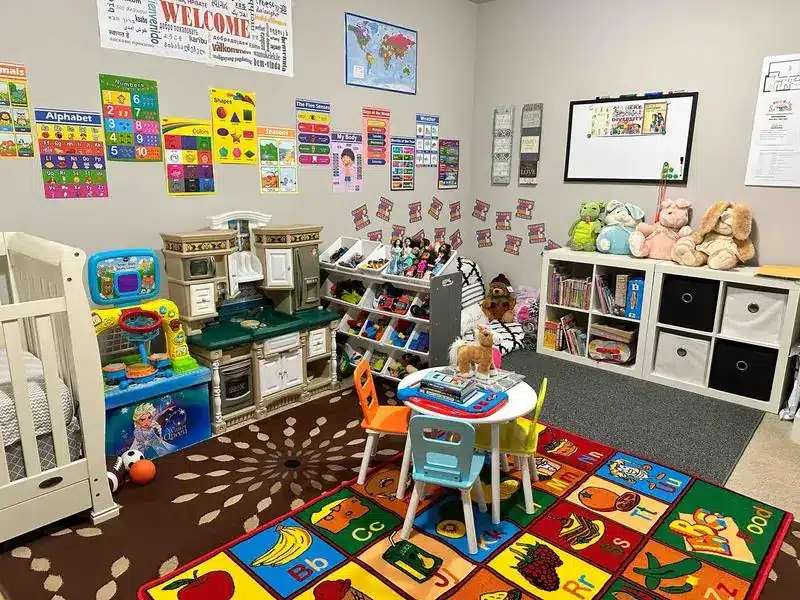
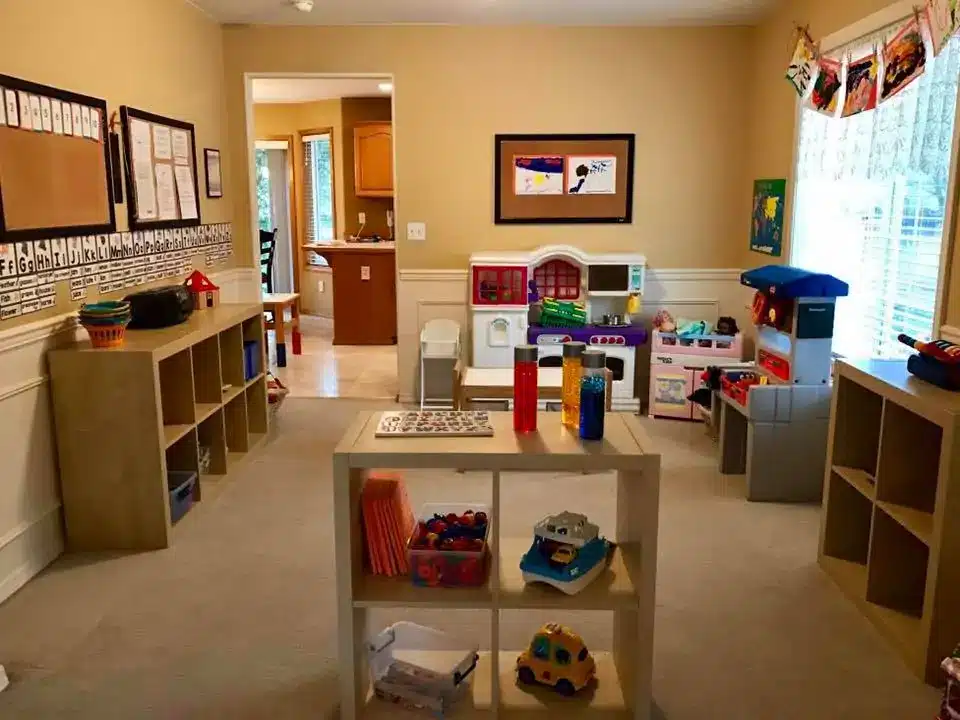
In the quest to equip small daycare environments, the selection of space-saving daycare equipment stands as a pivotal aspect. It’s not just about economizing space but about sculpting an environment that stimulates growth, creativity, and safety for children. By integrating multifunctional, durable daycare equipment, we pave the way for versatile learning and play areas within the confines of limited square footage.
Ultimately, the goal transcends mere space optimization. It’s about enriching the daycare setting with thoughtful, purposeful selections that foster an inviting, dynamic space conducive to learning and exploration. This careful consideration ensures that, despite spatial limitations, the possibilities for development and joy in learning remain boundless.













